OVER the last thirty years, Evan Wolfson has been everywhere fighting the good fight for GLBT equality. In 2000, he argued the Boy Scouts of America v. Dale case in front of the U.S. Supreme Court. In 2003, he founded Freedom to Marry, a national organization dedicated to winning marriage equality in all fifty states. His book Why Marriage Matters: America, Equality, and Gay People’s Right to Marry (2004) offered a passionate and deftly argued case for the expansion of civil marriage rights to include millions of lesbian and gay Americans. His commitment to this cause goes back to his 1983 (!) thesis at Harvard Law School, which laid out the case for fighting for the freedom to marry and how to win. In 2004, he was named to the “Time 100” list of the “most influential people in the world,” and, in 2011, Newsweek dubbed him “the godfather of gay marriage.”
I feel this struggle for our marriage rights keenly because Alistair McCartney, my Australian partner of almost twenty years, has been denied one of those crucial marriage rights that allowed only straight folks to sponsor their spouses for immigration. I first met Evan in 1997 in Bozeman, Montana, where Evan and I were the dog-and-pony show for Montana Pride—at a time when Alistair had just had his visa refused in Australia. I was in a crisis and Evan leapt into action to examine our very limited options. These kinds of difficulties persisted until the Defense of Marriage Act was overturned on June 26, 2013. Alistair and I were married in New York City that very afternoon; and Alistair received his Green Card in the mail in early November.
Evan clearly knows that the battle for marriage is very personal and impacts our emotional and practical well-being in the most profound ways. We met to talk at this tremendous moment of progress while sitting on cardboard cartons in the empty, soon-to-be-renovated West Village apartment that he shares with his husband Cheng He. This seemed the perfect place to engage in a conversation with Evan Wolfson about the extraordinary times we are living through as we bring the freedom to marry to all Americans.
— Tim Miller







